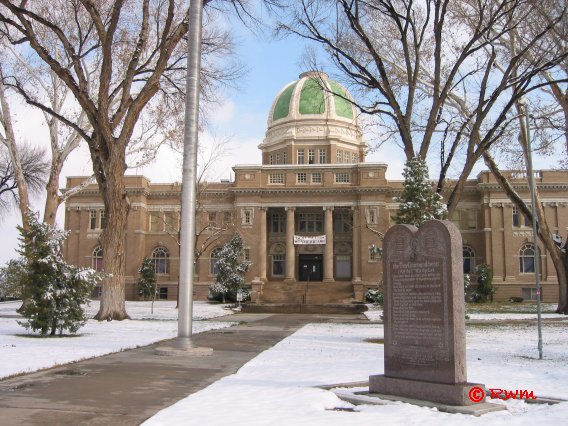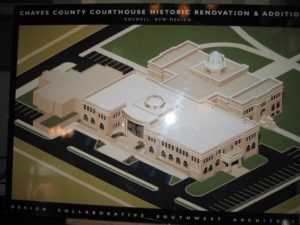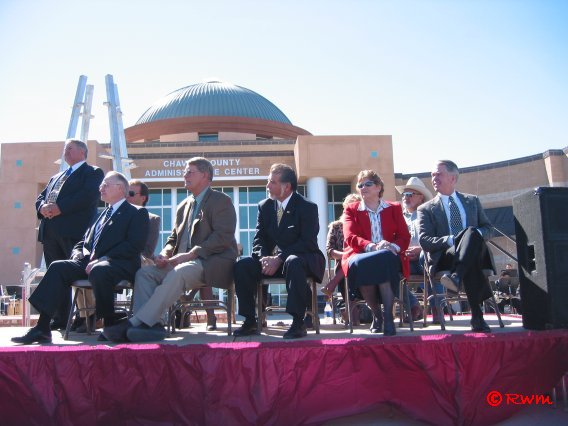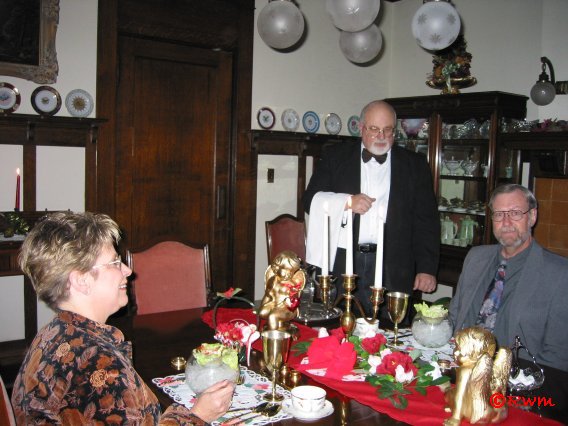
Main Street View
(Photo was taken New Year’s Day 2002, hours after first, and perhaps last, snow of the season.)
CHAVES COUNTY COURTHOUSE
Jean Willis, Court Administrator of the Fifth Judicial District, calls it the “Crown Jewel of Chaves County.”
Whenever he speaks of it, Judge Chip Johnson shows his pride in this beautiful historic building, with its magnificent green dome and rotunda. His efforts to preserve it and keep it in use also reflect his affection for it.
Architect Mary Ellen Brodrick of Design Collaborative Southwestern Architects in Albuquerque says it is, without question, the finest courthouse and the only one of its kind in the state of New Mexico.
Sharon Jackson, Chaves County’s Loss Control Specialist, said the building reflects the pride of its maintenance employees. Her job takes her to all of the state’s public buildings, she said. Although it is old, she found that this courthouse is cleaner and better maintained than any other in the state, a credit to its employees . The renovation, necessary for its continued use, will also renew the community’s pride, said Jackson. It will cause businesses and residents to become more progressive, she added.
Virginia Gutierrez of the County Manager’s office said tourists passing by are intrigued when they see the beautiful courthouse and often stop to come inside and look around. She said they are always impressed.
To preserve this historic Courthouse built in 1911, it is slated for renovation and additions carefully following the same style as the original. This is necessary to preserve the Chaves County Courthouse on Main Street in the center of Roswell, and allow its continued use by future generations.
A subsequent article will describe in depth the building’s existing infrastructural problems, the plans to bring it to code, and the changes and additions to be made that will enhance and increase the usage of this fine old building.
This is an architectural illustration, by Design Collaborative Southwest Architects, Inc., of the planned historic renovation and addition to the Chaves County Courthouse. The portion in the foreground is the addition and will face Virginia Avenue. The original courthouse faces the upper right-hand corner of the illustration.

Note that, after renovation and the addition, the view from Main Street of the Chaves County Courthouse and its landmark green dome will be preserved. The additions to the building will face Virginia Avenue and reflect the same style, including another dome and rotunda, as the original portion of the building that faces Main. Two magnificent facades will be even better than one.
The air was still under New Mexico’s traditionally clear turquoise-blue sky. Like the weather, the audience and speakers were warm and friendly.
Preceding days had been overcast, cold and blustery but Friday morning, February 22nd, speakers noted that all conditions were excellent on the special day honoring longtime Congressman Joseph R Skeen.
It may have been an important occasion but there was no pomposity. Throughout the festivities, there was much laughter and good-natured teasing, including from the Congressman and his wife.
The occasion was the dedication and official opening of the Chaves County Administrative Center — named the Joseph R. Skeen Building — at One St. Mary’s Place in Roswell. This beautiful new landmark building was built upon the site of a beloved longtime landmark, the red-bricked St. Mary’s Hospital, now gone, that served generations of Roswell and Chaves County residents. The hospital, opened in 1906, was begun by the Sisters of the Sorrowful Mother. Sister Roseann Koskie, representing that order, was one of many recognized that day.
The morning began with bands from Roswell High School, Goddard High School and New Mexico Military Institute playing patriotic music as the crowd gathered. The ceremonies officially began with the posting of colors by the NMMI Color Guard. The American flag they raised upon the tall staff in front of the building had flown over the nation’s capitol. As Sister Roseann read a prayer, three Air National Guard F-16s from Kirtkland Air Force Base flew in formation directly overhead.
Airplanes from Holloman Air Force Base also flew over during the ceremony.
Some dignitaries present at the open-air ceremony to honor Skeen and his wife, Mary, sat with them on the dais, but many more, from near and far, were scattered throughout the large audience.

U.S. Senator Pete Domenici was unable to be present. Through the reading of his letter by Poe Corn, Domenici told the audience, “I … convey my most sincere congratulations to the residents of Chaves County, the Chaves County Commissioners and to you, Hubert (Quintana, Chaves County Manager), for the many, many hours of planning, preparing, coordinating, discussing and staying on a course of action leading to the construction of this complex. It is an accomplishment (of which) … all present and future Chaves County residents can be proud.
“I have known Joe Skeen long before either of us was elected to the U.S. Congress. I know he has established a truly distinguished record of service in New Mexico and in Washington D.C. He has served in the United States Navy, and in the U.S. Air Force Reserves. He served in the New Mexico Legislature for 10 years, 6 of them as a minority leader, elected by his fellow senators. He unsuccessfully ran for both the New Mexico Lieutenant Governor’s seat and later for the Governor’s seat … in 1980 he successfully ran as a write-in candidate for New Mexico’s Second Congressional seat and he has been elected (to that) … for 11 consecutive terms.
“Joe will complete over 50 years of public service to our state and to our nation this coming December. The Joseph R. Skeen Building will serve as a constant tribute to a public servant who dedicated so much of his life to making Roswell and Chaves County a better place to live and work. Just as (he) has represented good government for New Mexico, I believe his record of achievement should serve as a reminder to those who work within this shiny new building of the importance of their jobs serving the people of Chaves County.
“Joe could not have had such a distinguished record of performance and accomplishment without the support and companionship of his wife, Mary, who has been with him every step of the way.”
In Domenici’s news release, he also stated: “The Skeen Building will allow the existing downtown (Chaves County) courthouse, which is listed on the national and state registers of historic places, to be more fully utilized by the courts, District Attorney’s office and related activities.”
Many spoke in honor of Skeen and his wife. Those included New Mexico’s Lt. Gov. Walter Bradley, U.S. Senator Jeff Bingaman and the county commissioners. Commissioner Alice Eppers told of her longtime association and friendship with Skeen, as a fellow rancher and as an employee in his Roswell office. Commissioner Jerry Wood recognized former commissioners Rory McMinn and Joe Adair for joining him in casting the three votes that created this center: its construction, location and name.
Others were recognized by Quintana, including county employees and the building supervisor who “made it happen.” Representatives of the three architectural and construction firms that designed and created the building were recognized. Judge Chip Johnson, formerly a district judge in Roswell and now an appointed federal judge in Albuquerque, was credited for his untiring efforts towards the historic renovation and preservation of the Chaves County Courthouse and, to alleviate crowding and allow for growth, the construction of this new county administrative building.
County Manager Hubert Quintana said:
“Welcome to the grand opening of your new Chaves County Administrative Center, the Joseph R. Skeen Building. This magnificent building, which took a year in design and 16 months in construction, is intended as a tribute to the people of Chaves County and our beloved Congressman Joseph R. Skeen. Like Congressman Skeen, the building is warm and friendly, and intended to provide easy access and service to everyone.
“Like the Congressman who has provided more than 50 years of public service to our residents, we hope our new building will provide for the people of Chaves County for generations to come.
“Congressman Skeen is a Roswell native, born and raised only a few blocks north of here. Our building incorporates the trademarks of our community long associated with county government and our beautiful courthouse. We have brought with us a dome, pillars, brick construction, sycamore trees, a rotunda, bluegrass-mix lawns — when we get them planted — and smiling faces.
“The Commission, like Joe Skeen, was insightful in deciding to locate on this site. The land was the County’s, and a new landmark was built to replace an old landmark. The new building reaches out to the residents of Chaves County, and embraces all residents as one family.
“The number three … is important … because three women were principally responsible for its design and construction. Architect Mary Ellen Broderick with Design Collaborative SouthWest Architects; Ellen Chamberlin, President of Luther Construction; and Katie Byrd-Humphries, President of Quality Control Engineering were essential to the project.
“(Skeen’s) deep sense of commitment is matched only by his deep love for our state and its people.
“The Board of Commissioners and people of Chaves County are honored to dedicate this building to Congressman Joseph R. Skeen, hero and role model for each of us.”
At the conclusion of the formal dedication, the Roswell Red Coats officially cut the ribbon and unveiled the building’s name, flanked by a formation of Roswell’s Youth ChalleNGe. (The capital NG in the name represents the group’s sponsor, New Mexico’s Army National Guard.)
Following the ribbon-cutting, the public entered it, through its expansive rotunda, to tour the Joseph R. Skeen Building for the first time, and to enjoy refreshments.
(Pictured above are Lt. Gov. Walter Bradley, Congressman Joe Skeen and Mary Skeen flanked by a crowd including Red Coats and Girl Scouts.)

Roswell’s Bernie and Kathi Link were served a Turn-of-the-Century candlelit Valentine dinner the evening of February 12, 2002 at the White House. Not the one in Washington D.C. The one in Roswell. They dined in the formal dining room of the J.P. White house. And no, the turn-of-the-century ambience wasn’t that of a couple years ago.
The Links were the winners of the raffle for the Victorian-era Valentine Dinner hosted by the Historical Society for Southeast New Mexico. The meal was specially prepared just for them by a professional chef and served by a frocked butler and two appropriately attired maids who waited in the kitchen to be summoned to their sides by the delicate tinkle of a bell.
Bill Brown was the chef; volunteer and board of directors member Mary Ann Schrank, and member and volunteer Madonna Darland were the maids-in-waiting. Butler was Roger Burnett, a Historical Society director. Brown, when he is not volunteering his time and talents to the Historical Society, is an independent chef available by appointment. He provided and prepared the meal, a gift he has given for this same occasion for three consecutive years. Schrank and Darland have also volunteered for the past three years as maids for this Valentine Dinner.
(Butler Roger Burnett, maid Mary Ann Schrank, chef Bill Brown and maid Madonna Darland wait in the kitchen for the tinkle of the bell to summon them to service.)
The dinner was served in a splendid setting amid fine antiques. The dining room was illuminated only by candlelight from arrangements on the sideboards on either side of the room and on the dining table. A red table runner and Battenburg lace placemats decorated the table. The centerpiece was a three-tier brass candelabra holding flickering red tapers, its base was adorned with a spray of greenery and pink and white roses. Matching gold cherubs completed the romantic centerpiece. Brass water goblets, Warwick china with a floral pattern trimmed in gold, and gold-toned tableware complemented the table’s ambience. White linen napkins were tucked into gold-toned napkin rings and coffee was served from a fine sterling silver service.
The centerpieces, table settings and linens were either pieces acquired by donation to the museum or loans for this special occasion from Historical Society members and Mary Lou Glass, a White granddaughter.
Brown’s menu was baked shrimp and Alaskan crab appetizer, garden fresh salad, Cornish game hen, Scandinavian vegetables, vegetable medley with mushrooms and roasted garlic, twice-stuffed baked potatoes and cherries jubilee. The desert was served in antique cut-glass crystal goblets.
Kathi Link was given two table favors, gifts from the Historical Society made by Society member Madonna Darland. One was a small black wrought-wire basket filled with a miniature bouquet of red and white roses and adorned with a red cardinal perched upon the basket’s handle. The other was a small white heart-shaped cushion made from a piece of an old finely stitched quilt.
This dinner is hosted by the Historical Society annually and grows more in popularity each year.
The origin of the Society goes back many years to 1907 when a meeting was held to organize the Old Settlers’ Society of Chaves County. That group’s main activity was the Old Settlers’ Day that became known as Old Timers’ Day. Later, the group evolved into the Chaves County Archaeological and Historical Society. Accrued artifacts began to be exhibited in one case in the public library building. Since the community’s pioneers were the ones most interested in the group and its collection, pioneers were the focus for the exhibits. In 1930, the Society became an auxiliary of the state museum and the display cases in the library multiplied.
Through the years, the Society had many changes in location, membership and active interest. Eventually “Archeological” was dropped from its name.
When the White heirs donated their family home in 1976, the Historical Society of Southeast New Mexico finally had a home for its acquired historical collection, including documents, and the White family had a lasting memorial to the memory of their parents, James Phelps White and Lou Tomlinson White.
The house, located at the corner of North Lea Avenue and West Second Street in Roswell, is listed in the National Register of Historical Places.
James — now known as the first J.P. White — was born in Gonzales, Texas in 1856 and began cattle ranching in the Texas Panhandle with his uncle, Major George Washington Littlefield. J.P., along with his brother Tom and his uncle George, moved his ranching operations to Chaves County in 1881. Here he became involved with agricultural, industrial and civic activities. J.P. died in 1934 at age 76.
Lou was born in 1879 at Taylor, Texas. She and her family, with parents Mr. and Mrs. David Young Tomlinson, moved to Roswell in 1898. Her father was a contract builder and locally built many homes, schools and businesses. Lou married J.P. in 1903 and they had four children. Lou was involved with the area’s church, social and civic activities. She lived in this house until her death at the age of 92 in 1972.
The four children of J.P. and Lou — J.P. Jr., born in 1904, Zoa Elizabeth, born in 1906, and twins Tom and George, born in 1908 — grew up in this house. The sons continued in the ranching and farming business and, except for George, all of their children raised their families in Roswell. Four grandchildren of J.P. and Lou continue to live in and near Roswell.
The father of Lou White was the contractor for the construction of this home and he did much of the work himself. Construction began in 1910 and was completed in 1912, the year of New Mexico’s statehood. The architecture or style of the home is called “Prairie” or “Schooner,” a design developed by Frank Lloyd Wright in the early 1900s. That style reflected in this house includes gentle sloping and overhanging roofs, various roof levels and large porches. The roof, originally pressed tin, was changed to red tiles in the early 1920s. The exterior walls are yellow brick brought from Fort Worth, Texas.
Several rooms, the portecochere and driveway north of the house were added in 1916. The third floor that has the archive collection and the basement were added in 1920.
The house has 14 rooms, plus three baths, the attic and basement. Ceilings are 10 1/2 feet high, all woodwork is oak, and the floors are hardwood. The house was steam-heated from a boiler in the basement and also had four wood-burning fireplaces.
During the era the house was built, it was standard for funeral services to be held in families’ homes. This house has a four-foot wide casket entry door. It has beveled glass windows set in leaded framework and stained glass windows. Many of the light fixtures were designed for use either by gas or electricity. Many of the house’s furnishings and embellishments had belonged to the J.P. White family. Additional donations to the viewing public of southeastern New Mexico now reside in the house.
The carriage house had a small apartment on the second floor for servants, and a hayloft. In the carriage house was kept the Whites’ automobile and horses and a milk cow. The cistern, the round tank east of the carriage house, collected water in case the town’s water supply failed.
This house, now a museum and home to the Historical Society of Southeast New Mexico, has additional uses. Besides offering glimpses of a gracious lifestyle from many decades gone by, it has archives and archivists available to scholars of local history on Friday afternoons. This antique-filled home is also available for special events — such as Victorian-era Valentine Dinners.
(Information about the Historical Society and the J.P. White house was provided by the Historical Center for Southeast New Mexico.)
 Roswell Web Magazine
Roswell Web Magazine